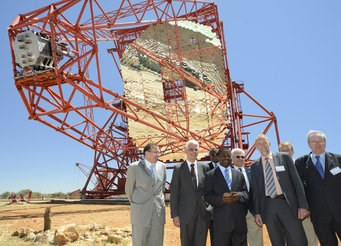A glimpse into turbulent space
H.E.S.S. II, the world’s largest Cherenkov telescope, is officially inaugurated.
The gamma-ray eye in Namibia’s Khomas highlands has acquired significantly greater acuity: The new H.E.S.S. II Telescope, officially dedicated last Friday, contains a 28-metre mirror and augments the H.E.S.S Observatory with its four 12-metre telescopes. The festivities began with a scientific symposium on Thursday and ended on Sunday with an open house.

In his ceremonial address for the dedication, Namibia's Minister of Education Abraham Iyambo acknowledged the prior groundbreaking discoveries of H.E.S.S. (High Energy Stereoscopic System) and the facility’s international acclaim. Namibia has become an important location on the research map as a result. With a view to junior scientists, the Minister hoped that many school children would be able to visit the observatory.
Daniel Weselka from the Austrian Ministry of Science and Research recalled the discovery of cosmic radiation by the telescope's namesake, Victor Hess, one hundred years ago. Eberhard Bodenschatz conveyed greetings on behalf of the Peter Gruss, President of the Max Planck Society, which financed approximately half of H.E.S.S. II. All of the speakers praised the international cooperation and the scientific, industrial and institutional contributions, without which such a project would not have been feasible.
Pressing the “red button”, Abraham Iyambo set the new gamma leader in motion at last. The guests were impressed by the synchronised motion of all five mirrors and with how quickly the 580 tonne H.E.S.S. II Telescope could be pointed at the desired location in the heavens. The automated mounting and dismounting of the three-tonne camera was demonstrated during a tour of the grounds.

The largest Cherenkov telescope constructed to date will observe the most energetic and extreme phenomena of the universe. The instrument promises researchers a deeper understanding of familiar high-energy cosmic radiation sources, such as super-massive black holes, pulsars and supernovae. The 28-metre mirror of the new telescope is equivalent to the surface area of two tennis courts.
The instrument had already seen the “first light” on 26 July and recorded images of atmospheric particle showers that were created by gamma rays or cosmic radiation. In particular, H.E.S.S. II will investigate energies around the band of a few tens of gigaelectron volts in the sky – a poorly researched transition band situated between space-borne instruments and contemporary ground-based telescopes that offers enormous potential for discoveries.
The construction of the telescope was expedited and financed mainly by German and French institutions. Significant contributions came from Austria, Poland, South Africa and Sweden. The Max Planck Institute for Nuclear Physics in Heidelberg participated significantly in the development and design of all of the components except for the camera and its electronics, and coordinated the set-up work. The Max Planck Society, with its share of the financing of almost 50 percent, was by far the largest financial contributor to H.E.S.S. II.
HOR / BF

